#pix4japan
Text

New Year's Daybreak at Shirahama
Location: Shirahama Beach, Shimoda, Shizuoka, Japan
Timestamp: 06:56 on January 3, 2024
Pentax K-1 II + DFA 28-105mm F3.5-5.6
31 mm ISO 800 for 1/640 sec. at ƒ8.0
My first visit to Shirahama Beach on the western coast of the Izu Peninsula located 175 km (107 mi) southwest of Tokyo was in the late 1980s. Barbecues on the beach, following a day of swimming or surfing, were popular back then. Unfortunately, as time passed, some beachgoers neglected to clean up after themselves, leading to the prohibition of beachside barbecues by the late 90s.
In response, local merchants and entrepreneurs initiated delivery services for food, drinks, beach umbrellas, and inflatable floats. They also patrolled the beach for litterbugs. Overall, this change significantly improved the beach's cleanliness for almost two decades now.
Most of my beach visits have been in summer, with a few during winter. However, this year marked my first New Year's holiday visit. After tending to the family graveyard, I took the scenic route home, making stops at Shirahama Beach and Shirahama Shrine for the traditional New Year's shrine visit (初詣・hatsumode) and to witness the first sunrise of the year (初日の出・hatsuhinode). Despite the usual recommendation to observe hatsuhinode on January 1st, I waited until January 3rd to avoid the beach crowds and heavy traffic back to Tokyo.
Setting up my camera and tripod for this shot, I paused to reflect. The crashing waves, gentle flow of seawater around beach stones, and the warm glow of the rising sun created a serene atmosphere. Amidst the fresh ocean breeze, contemplating my fortunes over the past 40 years, I found myself captivated by nature's beauty and felt grateful for the chance to appreciate this moment.
Google Maps links to Shirahama Beach, Shirahama Shrine, and links to sources of additional reading (Japanese and English) can be found in the most recent pix4japan blog post: https://www.pix4japan.com/blog/20240103-shirahama
#海の風景写真#静岡#下田#日の出#白浜海岸#pix4japan#pentax_dfa28105#pentaxk1mkii#seascape photography#Japan#Shirahama Beach
60 notes
·
View notes
Text
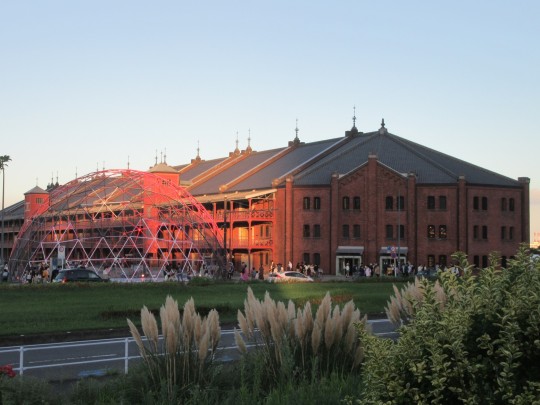

I'm back from a 5-week stay in Japan! It was quite the trip, including outings to Kyushu and Shikoku, Gion Matsuri and hanabi, a motor race at Fuji Speedway, and visiting 4 out of 5 National Treasure castles, having visited the fifth before.
I made a brief evening stop at Yokohama, which was a chance to see places I'd seen on here. I remember @kyokocanary777 showing Aka-Renga, which was swamped by the Pokémon World Championships when I was there, and I believe it was @pix4japan who posted about the Hikawa Maru and accompanying promenade and park.
So thank you to the aforementioned for inspiring the visit.
I wrote a diary blog - if you would like to see it, I'll communicate the address by private message.
2 notes
·
View notes
Photo

Yokohama Chinese Spring Festival
The Yokohama Chinese Spring Festival is running from January 22nd to February 5th in Yokohama Chinatown and the Minatomirai district.
Check out our blog for more details:
https://rent-life.blogspot.com/2023/01/yokohama-chinese-spring-festival.html
Photo credit: © 2023 Pix4Japan. All rights reserved. Used with Permission.
0 notes
Text
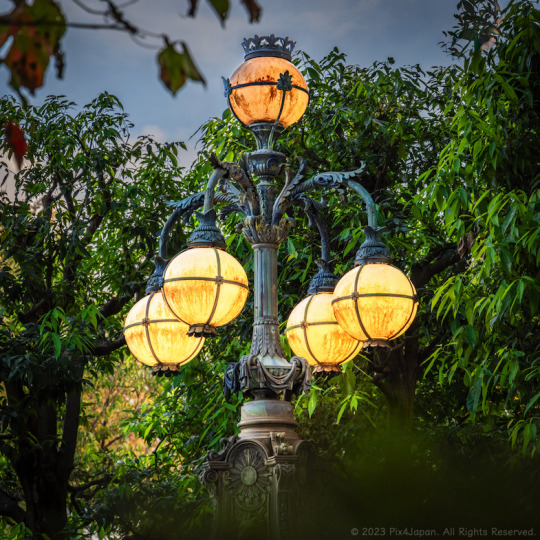
Restored Tokyo Imperial Palace Bridge Lamp from 1888
Location: Edo-Tokyo Open Air Architectural Museum, Tokyo
Timestamp: 16:12 on October 25, 2023
Pentax K-1 II + DFA 28-105mm F3.5-5.6
105 mm ISO 200 for 1/125 sec. at ƒ/7.1
Captured in this image is an ornamental electric light, a stunning example of Baroque style, originally positioned at the main gate of the Imperial Palace in Chiyoda Ward, Tokyo, from the late 1880s to the mid-1890s.
In my most recent blog post (https://www.pix4japan.com/blog/20231025-bridge-lamp), I explore the history of the German manufacturer of the lamp and their influence on Japan's modernization (3-minute read).
#都市景観#皇居正門石橋飾電燈#江戸東京たてもの園#東京#pix4japan#pentax_dfa28105#pentaxk1mkii#urbanscape photography#Tokyo#Japan#Edo-Tokyo Open Air Architectural Museum
81 notes
·
View notes
Text

Rest and Rejuvenation: Unveiling the Goronekan Respite in Yamanashi
Location: Fujikawaguchiko, Yamanashi Pref., Japan
Timestamp: 11:55・2024/03/20
Pentax K-1 II + DFA 28-105mm F3.5-5.6 + CP
31 mm ISO 100 for 1/320 sec. at ƒ/8
The Goronekan is a meticulously restored thatched-roof structure within the Saiko Iyashi-no-Sato Nenba open-air museum, in Yamanashi Prefecture, Japan, offers visitors a serene retreat. Additionally, it serves as an intimate venue for small concerts featuring traditional Japanese musical instruments, adding a cultural dimension to its charm.
The name itself, Goronekan, translates to "Falling asleep in one's clothes to take a nap" combined with "public building." Essentially, Goronekan serves as a respite for weary visitors, offering a place to rest and rejuvenate on traditional tatami mats or wooden floors after exploring the village's many attractions.
Perched at the highest point of the open-air museum, Goronekan treats visitors to a majestic vista of Mount Fuji, framed by the quaint thatched roofs of neighboring buildings, provided the weather cooperates.
For a deeper delve into the other activities available at Goronekan, including Google Maps links, sources, and references for further reading, check out the full write-up—a short 1-minute read (https://www.pix4japan.com/blog/20240320-goronekan).
#風景写真#山梨県#西湖いやしの里根場#ごろ寝館#pix4japan#pentax_dfa28105#pentaxk1mkii#landscape photography#Japan#Yamanashi Prefecture#Saiko Iyashi-no-Sato Nenba#Goronekan
17 notes
·
View notes
Text
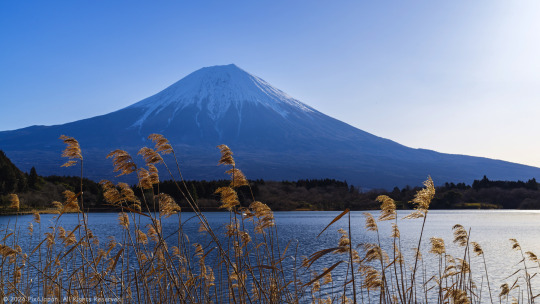
From Fodder to Roofing: Pampas Grass and Thatched Roofs in Modern-Day Japan
Location: Lake Tanuki, Shizuoka, Japan
Timestamp: 08:02・2024/02/28
Pentax K-1 II + DFA 28-105mm F3.5-5.6 + CP
48 mm ISO 100 for 1/100 sec. at ƒ/11
For over five centuries, pampas grass was ingrained in the daily lives of the Japanese people. It served not only as fodder for cattle and horses but also as a key component for thatched roofs.
Following World War II, the surge in economic growth had a profound impact on the landscape of traditional houses, which underwent a transformation into Western-inspired designs along with a shift in roofing materials. Additionally, the utilization of natural roofing materials became restricted, primarily confined to heritage sites as dictated by revised building codes.
While thatched roofs are commonly associated with farmhouses and mountain dwellings today, certain structures like buildings and gates at shrines and temples continue to embrace this traditional roofing material.
From its historical significance in thatched roofs to the contemporary challenges faced by skilled thatchers, discover the journey of pampas grass, contributing to nationwide repairs on cultural landmarks, including national treasures and significant cultural properties at the full write-up, which includes Google Maps links and references for further reading (https://www.pix4japan.com/blog/20240228-pampas).
#風景写真#富士山#田貫湖#薄#ススキ#pix4japan#pentax_dfa28105#pentaxk1mkii#landscape photography#Japan#Mt. Fuji#Lake Tanuki#pampas grass
22 notes
·
View notes
Text
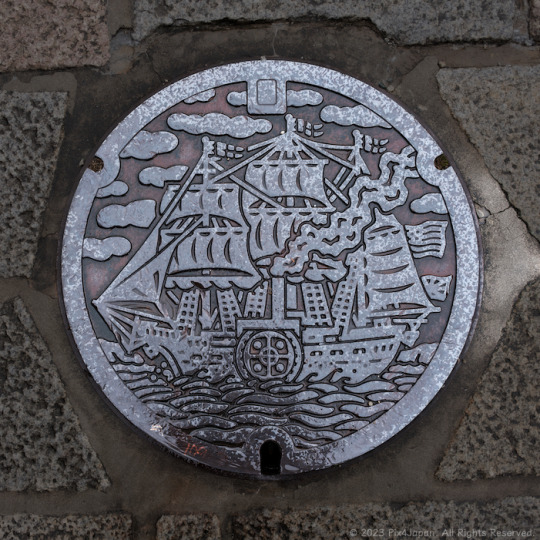
Manhole Cover of City of Shimoda
Location: Perry Road, Shimoda, Shizuoka Prefecture, Japan
Timestamp: 15:23 June 6, 2023
One of the sites where US Naval Commodore Perry initially landed in Japan, demanding an end to Japan's extensive period of isolation spanning over 200 years, and advocating for trade with the Western world through the use of gunboat diplomacy, has been immortalized in the history books. The city of Shimoda is the location where the Treaty of Peace and Amity was signed in 1854 between the US Government and the Japanese Tokugawa shogunate.
Within this city, there exists many unique manhole covers that pay homage to the iconic "Black Ships." These legendary vessels earned their name from the Japanese people themselves, owing to their distinctive black hulls and the billowing black smoke emitted by their coal-fired steam engines.
Checkout the Pix4Japan blog for historical references, further details, and geotagged locations (link in Bio).
Fujifilm X100V (23 mm) with 5% diffusion filter
ISO 160 for 1/280 sec. at ƒ/2.2
Classic Chrome film simulation
#black ship#manhole cover#Shimoda#Shizuoka Prefecture#Japan#street photography#Fujifilm#X100V#pix4japan#マンホール#黒船#下田市#静岡県#ストリートスナップ
127 notes
·
View notes
Text
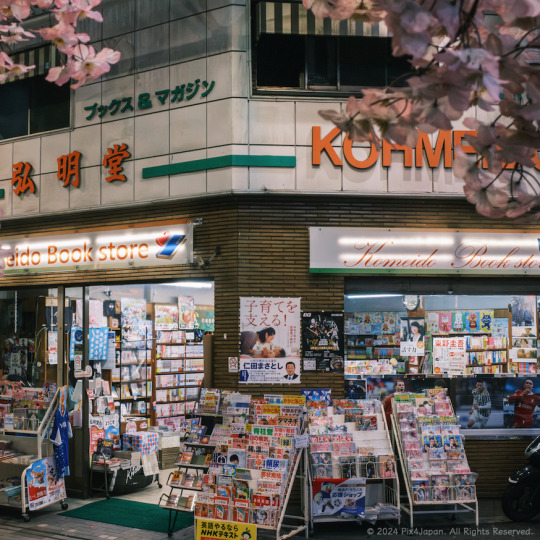
Komeido Bookstore at Gumyoji Shotengai
Location: Gumyoji, Minami Ward, Yokohama, Japan
Timestamp: 17:12・2024/04/09
Fujifilm X100V with 5% diffusion filter
ISO 3200 for 1/140 sec. at ƒ/13
Classic Negative film simulation
Located at the eastern entrance to the Gumyoji Kannon Street Shopping Arcade (Gumyoji Shotengai), just a minute's walk from Gumyoji Station on the municipal Blue Line subway, lies the Komeido Shoten bookstore.
Rooted in its origins dating back to around 1940, Komeido Shoten is presently under the stewardship of its third-generation owner. The bookstore underwent renovation in 2008, expanding its offerings to encompass a diverse range of books within its 49.58 square-meter (533.67 square-foot) premises.
Among its collection, one can find a plethora of comics, magazines, and novels. Notably, the selection leans less towards business-oriented titles and more towards catering to the preferences of its core clientele, which predominantly comprises students, housewives, and retirees from the local community.
A unique feature of the bookstore is its practice of including small gifts and product samples with many of its books, a gesture that resonates particularly well with the cost-conscious women who frequent the establishment. Furthermore, in recognition of the large student population in the vicinity, the store maintains a well-stocked inventory of relevant textbooks to meet their academic needs.
For links to Google Maps and additional source references, please check out my latest write-up, a concise 1-minute read (https://www.pix4japan.com/blog/20240409-komeido).
#ストリートスナップ#横浜#弘明寺商店街#弘明堂書店#pix4japan#FujifilmX100V#street photography#Japan#Yokohama#Gumyoji Shotengai#bookstore
15 notes
·
View notes
Text
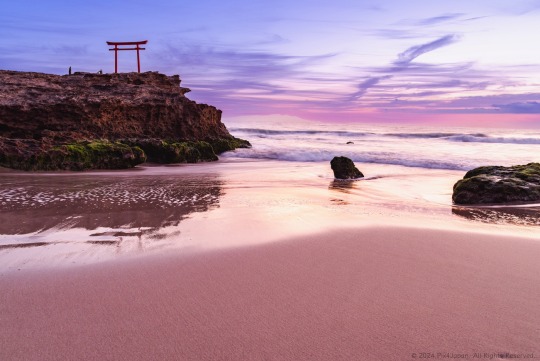
Torii Gate on Reef Facing the Rising Sun
Location: Shirahama, Shimoda, Shizuoka, Japan
Timestamp: 06:30 on January 3, 2024
Pentax K-1 II + DFA 28-105mm F3.5-5.6
28 mm ISO 100 for 0.5 sec. at ƒ/8.0
Located within a 3-hour drive of Tokyo, Shirahama Beach is a popular destination for beachgoers and surfers during the summer. While surfers are still present during the colder months, the beach is mostly empty, providing an opportunity to experience long stretches of sand free of human footprints.
At the northern end of the beach lies Daimyojin-Iwa (大明神岩), roughly translated to “rock of deity with extraordinary spiritual powers.” Atop Daimyoji Iwa stands a red torii gate facing the sea. The torii belongs to Ikona-hime-no-Mikotojinja Shrine, commonly known as Shirahama Shrine, the oldest Shinto shrine on the Izu Peninsula, and is only a 2-minute walk from the shoreline.
During midday, you can enjoy the lovely white sands and deep turquoise sea that stand in stark contrast with the red torii gate. If you visit early in the morning, however, you can experience beautiful skies and a sandy shore blanketed in a soft coral pink hue.
Google Maps links to this destination, and links to sources of additional reading can be found in the most recent pix4japan blog post: https://www.pix4japan.com/blog/20240103-shirahama
#海の風景写真#白浜海岸#大明神岩#白濱神社#pix4japan#pentax_dfa28105#pentaxk1mkii#seascape photography#Japan#Izu#Shimoda#Shirahama Beach
27 notes
·
View notes
Text


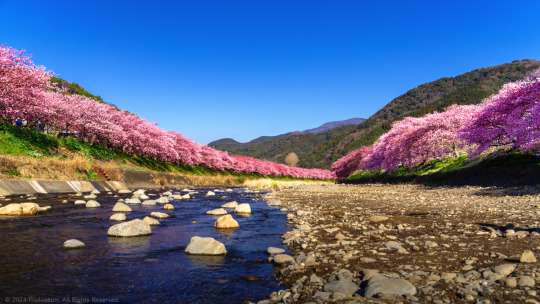
Chasing Early Bloom: Kawazu-Zakura Festival 2024
Location: Kawazu River, Kawazu, Shizuoka, Japan
Timestamps: 08:18, 08:20, and 08:40 on February 14, 2024
Pentax K-1 II + DFA 28-105mm F3.5-5.6 + CP
① 68 mm ISO 100 for 1/100 sec. at ƒ/10
② 28 mm ISO 100 for 1/160 sec. at ƒ/9.0
③ 31 mm ISO 100 for 1/200 sec. at ƒ/7.1
My first visit to the Kawazu-Zakura Cherry Blossom Festival was on March 2, 2022, two days after the festival had officially ended. This year, I timed my visit to the festival to coincide with a photo shoot at Imaihama Beach, which is just a 10-minute from the Kawazu River where the cherry trees are situated.
While the annual cherry blossom festival officially extends until February 29th, locals I spoke with anticipated tourists continuing to visit as late as the first week of March.
Here are three of my favorite shots along the Kawazu River:
① The first shot was taken on the eastern end of Kinomiya Bridge (来宮橋), crossing Kawazu River, about an 18-minute walk from Kawazu Station. Looking north, a glimpse of the vermilion-colored Hosen Bridge (豊泉橋) adds to the scenic view.
② The second shot was taken a few meters north of Kinomiya Bridge on the eastern riverbank. This spot provided ample foliage and shadows to almost hide the buildings and man-made structures behind the cherry trees, creating a nice contrast with the dark Kawazu-zakura pinks against the evergreen hills in the background.
③ The third shot was captured from the middle of the riverbed, right across from the tourist information booth on the northern riverbank, a 26-minute walk from Kawazu Station.
For those planning to visit the festival by train, I have included a link to Donny Kimball’s “Come to Kawazu | Enjoy Japan’s Cherry Blossoms in February” blog post, where he recommends the best way to reach the festival by train.
If, like me, you travel with a border collie, driving is the only option. From central Tokyo, it's a 2-hour 30-minute to 3-hour drive (depending on traffic). Kawazu Town is only 185 km southwest of central Tokyo, so even if you avoid the expressways, you can still reach this destination in less than 4 hours if you leave early enough in the morning.
For photographers attending this festival, try to schedule your visit on a weekday early in the morning. With very few crowds, it becomes easy to set up a tripod to bracket your shots, take long exposures of the river, or capture some panoramas.
If you have time, I'd recommend taking a leisurely drive home via Route 135, running the entire length of the eastern coastline of the Izu Peninsula. Roll down the windows, let the sea breeze enter the cabin, and be sure to stop at any of the numerous roadside rest stops that often offer spectacular views of the coastline.
I've gone into greater details on how to access the festival by car and have gathered with great info, downloadable PDF maps, and have Google Maps links to 3 of the larger parking lots. The write-up is less than a 3-minute read (https://www.pix4japan.com/blog/20240214-kawazu-zakura).
#風景写真#伊豆半島#河津町#河津桜#pix4japan#pentax_dfa28105#pentaxk1mkii#landscape photography#Japan#Shizuoka Prefecture#Kawazu Town#Kawazu cherry blossoms
22 notes
·
View notes
Photo

Mt. Fuji Towering Over Coastal Concrete Barrier
Location: Miho Peninsula, Shizuoka Prefecture, Japan
Timestamp: 15:19 April 5, 2023
Typically, when people think of Mt. Fuji, they imagine a breathtaking snow-capped mountain set as a backdrop of natural beauty. This may include freshwater lakes, rows of flowerbeds, expansive beaches, or high-elevation shots of city lights. However, for me, the scene has a distinct street-photography vibe.
As I gaze upon the majestic mountain, I am struck by the juxtaposition of man-made structures that have contributed to the destruction of the once white sands of this particular beach. It's a stark reminder of the impact humans have on the environment, and how our actions can last for centuries to come.
Despite this destruction, Mt. Fuji remains one of Japan's most important symbols of natural beauty and is revered by adherents of the native belief system of Shintoism, where the mountain is considered one of the more important gods.
The scene before me is a testament to the complexity of human-nature interactions and the importance of respecting and preserving our natural surroundings. It serves as a reminder that we must strive to strike a balance between our modern way of life and our responsibility to protect the planet for future generations.
Pentax K-1 II + DFA 28-105mm F3.5-5.6
63 mm ISO 100 for 1/200 sec. at ƒ/11
#海景写真#静岡県#駿河湾#富士山#三保松原#テトラポッド#4脚ブロック#pix4japan#pentax_dfa28105#pentaxk1mkii#seascape photography#Japan#tetrapod#Shizuoka#concrete#Mt. Fuji
146 notes
·
View notes
Text
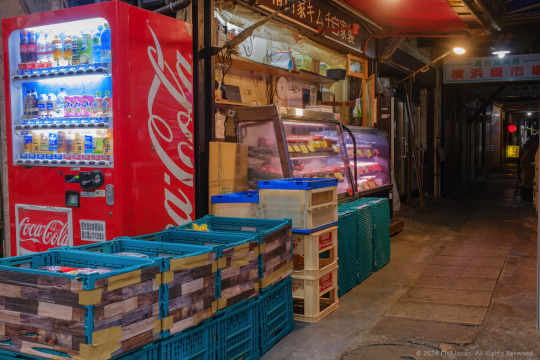
Savoring Korean Tradition: Exploring Yokohama's Kimchi Haven
Location: Yokohamabashi, Minami Ward, Yokohama, Japan
Timestamp: 18:52 on December 19, 2023
Fujifilm X100V with 5% diffusion filter
ISO 160 for 1.0 sec. at ƒ/10
Astia/Soft film simulation
Explore a hidden gem of Yokohamabashi Shotengai, where Namusanya Kimchi stands as a unique haven for authentic Korean kimchi. Nestled in a dimly lit alley, this quaint shop offers a tantalizing display of fermented delights, complemented by popular Korean instant ramen brands.
Despite its unassuming exterior, Namusanya Kimchi earns glowing reviews for its affordable bulk kimchi that resonates with the homemade touch of aunties and grannies. Owned by Shin-san, a third-generation proprietor with over 40 years of legacy, the shop's success is rooted in the meticulous preparation and months-long fermentation of their signature kimchi.
Dive deeper into the rich flavors, 40-year history, and links to six other kimchi shops at Yokohamabashi Shotengai by visiting the full blog post: https://www.pix4japan.com/blog/20240205-yokohama-kimchi-haven (2-minute read).
#ストリートスナップ#横浜#横浜橋商店街#昭和レトロ#キムチ#pix4japan#X100V#Fujifilm#street photography#Japan#Yokohama#Yokohamabashi#Korean food#kimchi
23 notes
·
View notes
Text
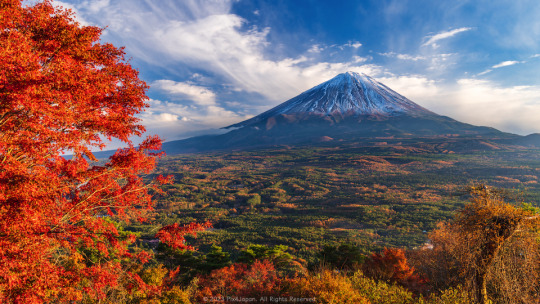
Momiji Autumnal Leaves & Mt. Fuji
Location: Koyodai Observatory Terrace, Narusawa Village, Yamanashi Prefecture, Japan
Timestamp: 15:58 on November 15, 2023
Pentax K-1 II + DFA 28-105mm F3.5-5.6
28 mm ISO 100 for 1/30 sec. at ƒ/11
Using the Pentax “Pixel Shift Resolution II” feature, I captured four full-resolution photos of this scene from the 2nd floor landing at the Koyodai-Tenbodai Rest House. These shots, processed in-camera, synthesize the 4 shots into a single, super-high-resolution composite image. This not only enhances the resolving power but also eliminates false color, reduces high-sensitivity noise, and significantly improves overall image quality.
Positioning your tripod in the left corner of the landing on the 2nd flat of stairs provides an unobtrusive vantage point for capturing the breathtaking scene. The Japanese maple tree visible from the second floor of the Koyodai Observatory Terrace adds a captivating foreground element, complementing the vibrant autumn colors in the lower mid-ground of the scene.
For more in-depth information on the history of the Koyodai-Tenbodai Rest House, optimal parking locations, and nearby bus stops, check out my blog post. I hope to guide you through planning a visit to this off-the-beaten-path site, offering a serene experience away from the typical tourist crowds:
https://www.pix4japan.com/blog/20231115-koyodai
#風景写真#紅葉#山梨県#富士山#紅葉展望台レストハウス#pix4japan#pentax_dfa28105#pentaxk1mkii#landscape photography#Japan#Yamanashi Prefecture#Mt. Fuji#Koyodai Terrace
34 notes
·
View notes
Text
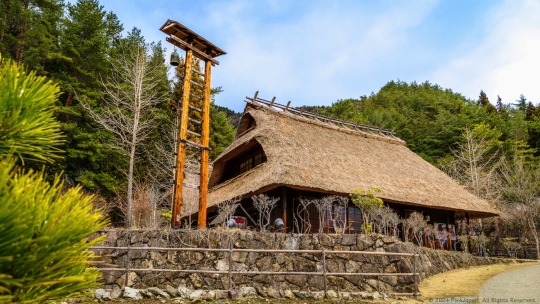
From Fire Lookout to Costume Haven: Hinomiya Building in Saiko Iyashi-no-Sato Nenba
Location: Fujikawaguchiko, Yamanashi Pref., Japan
Timestamp: 12:02・2024/03/20
Pentax K-1 II + DFA 28-105mm F3.5-5.6 + CP
28 mm ISO 100 for 1/40 sec. at ƒ/11
The Hinomiya building (火の見屋) is a restored thatched-roof house currently being used as a costume rental shop within the Saiko Iyashi-no-Sato Nenba open-air museum in Yamanashi Prefecture, Japan. Visitors can rent costumes tailored as kimonos, sets of samurai armor, ninja costumes, and more to wear and pose for photos around the museum.
The name 'Hinomi' (火の見) translates to “fire lookout,” which explains the presence of a bell at the top of the tower situated in the front yard of this old restored house.
In pre-modern Japan, many villages and cities were constructed from flammable materials such as wood, bamboo, straw, and paper. Due to the proximity of structures, fires could easily spread. In response, the Shogunate mandated the construction of watch towers in 1723. For further insight into this historical context, consider reading “Fire-Fighting and Disaster Prevention in Edo” published by the Journal of Japanese Trade & Industry in November/December 2000, authored by historian Sumiyoshi Yamamoto.
Check out the full write-up (a short 1-minute read) for Google Maps links, and references for further reading (https://www.pix4japan.com/blog/20240320-hinomiya).
#風景写真#山梨県#西湖いやしの里根場#火の見屋#pix4japan#pentax_dfa28105#pentaxk1mkii#landscape photography#japan#yokohama#Saiko Iyashi-no-Sato Nenba#Hinomiya
13 notes
·
View notes
Text

Tachinomidokoro Maimeri: A No-Frills Standing Bar Serving Takoyaki in Japan
Location: Yokohamabashi, Minami Ward, Yokohama, Japan
Timestamp: 17:42 on December 19, 2023
Fujifilm X100V with 5% diffusion filter
ISO 3200 for 1/125 sec. at ƒ/6.4
Provia/Standard film simulation
Tachinomidokoro Maimeri, despite its signage emphasizing takoyaki (octopus dumplings), is actually a no-frills standing bar that serves beer, whiskey, nihonshu (Japanese sake), and shochu (distilled spirits made from grains or vegetables), along with non-alcoholic drinks, accompanied by takoyaki and other small side dishes.
This establishment, like many others in Japan, caters to those seeking a quick drink and affordable side dishes in a communal setting.
Originating from the Edo Period (1603-1867) in Tokyo's Kanda district, standing bars were initially operated in front of liquor stores. Today, places like Maimeri, often located near train stations and in working-class neighborhoods, preserve the tradition of offering a space for salarymen to unwind after a hard day's work.
Maimeri stands out in that it focuses on selling ready-made takoyaki in the afternoon that customers can take home and enjoy with their lunch or as a quick snack, a popular street food.
While the aging demographic of standing bar patrons is noticeable, the allure lies in the accessibility of these establishments. Affordability and proximity attract individuals of varying ages, backgrounds, and professions, providing an opportunity to experience the history and atmosphere of the local area.
However, enjoying a standing bar comes with its own set of manners. It's advisable to visit alone or with a friend, leaving ample space for others. Attempting to gather in large groups may overcrowd the place, disrupting the communal experience these bars offer.
Whether you're a local or a visitor, experiencing a standing bar like Maimeri provides a unique glimpse into Japan's culture and social dynamics. So, next time you find yourself near one, step in, savor the affordable drinks and snacks, and try to make a new acquaintance in the process.
Google Maps links to Maimeri, references for further reading, and source materials can be found at the latest blog post at pix4japan: https://www.pix4japan.com/blog/20231219-yokohamabashi
#ストリートスナップ#横浜#横浜橋商店街#昭和レトロ#立ち飲み処まいめり#pix4japan#X100V#Fujifilm#street photography#Japan#Yokohama#shotengai#Yokohamabashi
21 notes
·
View notes
Text

Edokko Shoten: Over 60 Years as Grilled Eel Masters
Location: Yokohamabashi, Minami Ward, Yokohama, Japan
Timestamp: 17:37 on December 19, 2023
Fujifilm X100V with 5% diffusion filter
ISO 3200 for 1/125 sec. at ƒ/8.0
Astia Soft film simulation
Embark on a culinary journey at Edokko Shoten, an esteemed establishment boasting a legacy of over 60 years. Nestled in tradition, this hidden gem specializes in grilled eel, offering a small variety of flavors that transport diners to the heart of authentic Japanese cuisine.
At Edokko Shoten, the culinary experience extends beyond the exquisite kabyaki grilled eel. Complementing this specialty, the shop offers an array of side dishes perfect to accompany a bowl of white rice. Among these delights are candied herring, tamba black soybeans, dried sweet squid, dried sweetened river shrimp, and more, each carefully prepared with sweet soybean-based sauces.
To ensure the freshest possible grilled eel, the shop starts each day by acquiring live eels from Shizuoka Prefecture, preparing them from start to finish.
The term “kabayaki” refers to the method of grilling, a popular technique for cooking seafood. The eel undergoes a careful process—it is gutted, boned, and butterflied before being marinated in a mixture of soy sauce, sake, sugar, and other seasonings, culminating in the flavorful grilled dish that is dearly loved in Japan.
Dating back to the Edo period (1603—1868), kabayaki eels were a staple in Japanese cuisine, known for their affordability and widespread popularity. In modern times, due to dwindling eel populations, kabayaki has become a more expensive delicacy, often enjoyed as a luxurious treat.
For those seeking an authentic Japanese dining experience, Edokko offers a selection of 4 kabayaki eel dishes, with prices ranging from ¥1,500 to ¥2,400 ($11 to $17 USD). Additionally, the menu features tantalizing side dishes, elevating your simple lunch or dinner into a slightly luxurious meal with the unmistakable taste of Japan.
Google Maps links, references for further reading, and source materials can be found at the latest blog post at pix4japan: https://www.pix4japan.com/blog/20231219-yokohamabashi
#ストリートスナップ#横浜#横浜橋商店街#昭和レトロ#江戸っ子商店#pix4japan#X100V#Fujifilm#street photography#Japan#Yokohama#shotengai#Yokohamabashi
22 notes
·
View notes